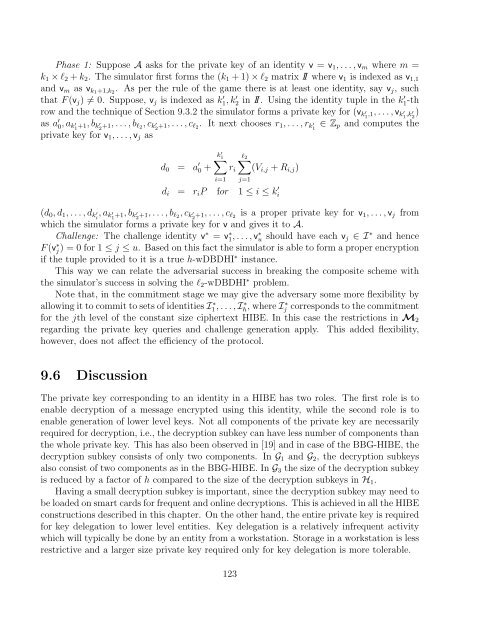Identity-Based Encryption Protocols Using Bilinear Pairing
Identity-Based Encryption Protocols Using Bilinear Pairing
Identity-Based Encryption Protocols Using Bilinear Pairing
Create successful ePaper yourself
Turn your PDF publications into a flip-book with our unique Google optimized e-Paper software.
Phase 1: Suppose A asks for the private key of an identity v = v 1 , . . . , v m where m =<br />
k 1 × l 2 + k 2 . The simulator first forms the (k 1 + 1) × l 2 matrix II where v 1 is indexed as v 1,1<br />
and v m as v k1 +1,k 2<br />
. As per the rule of the game there is at least one identity, say v j , such<br />
that F (v j ) ≠ 0. Suppose, v j is indexed as k 1, ′ k 2 ′ in II. <strong>Using</strong> the identity tuple in the k 1-th<br />
′<br />
row and the technique of Section 9.3.2 the simulator forms a private key for (v k ′<br />
1 ,1, . . . , v k ′<br />
1 ,k 2 ′ )<br />
as a ′ 0, a k ′<br />
1 +1, b k ′<br />
2 +1, . . . , b l2 , c k ′<br />
2 +1, . . . , c l2 . It next chooses r 1 , . . . , r k ′<br />
1<br />
∈ Z p and computes the<br />
private key for v 1 , . . . , v j as<br />
k ′ 1<br />
∑<br />
d 0 = a ′ 0 +<br />
i=1<br />
r i<br />
l 2<br />
∑<br />
j=1<br />
(V i,j + R i,j )<br />
d i = r i P for 1 ≤ i ≤ k ′ i<br />
(d 0 , d 1 , . . . , d k ′<br />
i<br />
, a k ′<br />
1 +1, b k ′<br />
2 +1, . . . , b l2 , c k ′<br />
2 +1, . . . , c l2 is a proper private key for v 1 , . . . , v j from<br />
which the simulator forms a private key for v and gives it to A.<br />
Challenge: The challenge identity v ∗ = v1, ∗ . . . , vu ∗ should have each v j ∈ I ∗ and hence<br />
F (vj) ∗ = 0 for 1 ≤ j ≤ u. <strong>Based</strong> on this fact the simulator is able to form a proper encryption<br />
if the tuple provided to it is a true h-wDBDHI ∗ instance.<br />
This way we can relate the adversarial success in breaking the composite scheme with<br />
the simulator’s success in solving the l 2 -wDBDHI ∗ problem.<br />
Note that, in the commitment stage we may give the adversary some more flexibility by<br />
allowing it to commit to sets of identities I1, ∗ . . . , Ih ∗, where I∗ j corresponds to the commitment<br />
for the jth level of the constant size ciphertext HIBE. In this case the restrictions in M 2<br />
regarding the private key queries and challenge generation apply. This added flexibility,<br />
however, does not affect the efficiency of the protocol.<br />
9.6 Discussion<br />
The private key corresponding to an identity in a HIBE has two roles. The first role is to<br />
enable decryption of a message encrypted using this identity, while the second role is to<br />
enable generation of lower level keys. Not all components of the private key are necessarily<br />
required for decryption, i.e., the decryption subkey can have less number of components than<br />
the whole private key. This has also been observed in [19] and in case of the BBG-HIBE, the<br />
decryption subkey consists of only two components. In G 1 and G 2 , the decryption subkeys<br />
also consist of two components as in the BBG-HIBE. In G 3 the size of the decryption subkey<br />
is reduced by a factor of h compared to the size of the decryption subkeys in H 1 .<br />
Having a small decryption subkey is important, since the decryption subkey may need to<br />
be loaded on smart cards for frequent and online decryptions. This is achieved in all the HIBE<br />
constructions described in this chapter. On the other hand, the entire private key is required<br />
for key delegation to lower level entities. Key delegation is a relatively infrequent activity<br />
which will typically be done by an entity from a workstation. Storage in a workstation is less<br />
restrictive and a larger size private key required only for key delegation is more tolerable.<br />
123
















